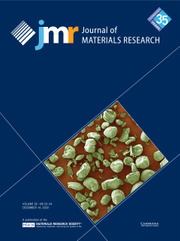Article contents
Chemical-vapor-deposition growth and characterization of epitaxial 3C–SiC films on SOI substrates with thin silicon top layers
Published online by Cambridge University Press: 31 January 2011
Abstract
Epitaxial 3C–SiC films were grown by chemical vapor deposition on the silicon-on-insulator (SOI) substrates with 20–75-nm-thick Si top layers. A relatively low growth temperature of 1150 °C and a reduced hydrogen flow rate of 1 lpm during the precarbonization process was necessary to preserve the SOI structure and thereby obtain high-quality SiC films. The transmission electron microscopy observation of the SiC/SOI structures revealed high density of misfit dislocations in the SiC film, but no dislocation within the top Si layer. The x-ray-diffraction results did not show any significant shift of the (400) SiC peak position among the SiC/Si and the SiC/SOI samples. This strongly suggests that the Si top layer is not deformed during the SiC/SOI growth and the strain within the 3C–SiC layer is not critically affected by substituting the Si substrate with the SOI substrate, even when the Si top layer is as thin as 20 nm.
Information
- Type
- Articles
- Information
- Copyright
- Copyright © Materials Research Society 2001
References
REFERENCES
- 5
- Cited by

